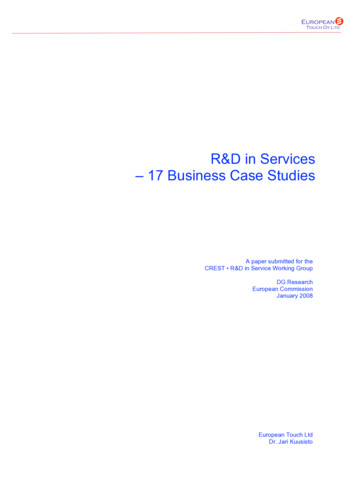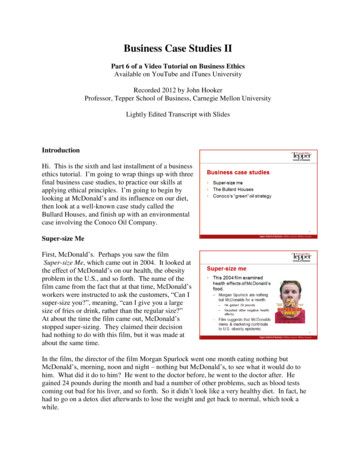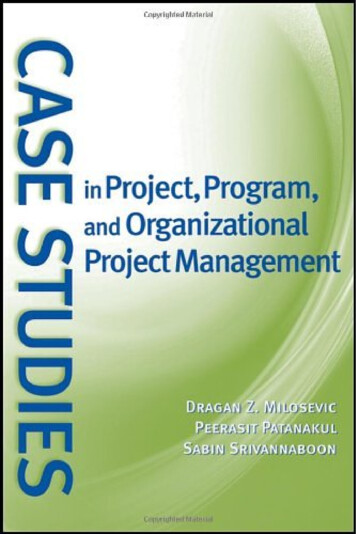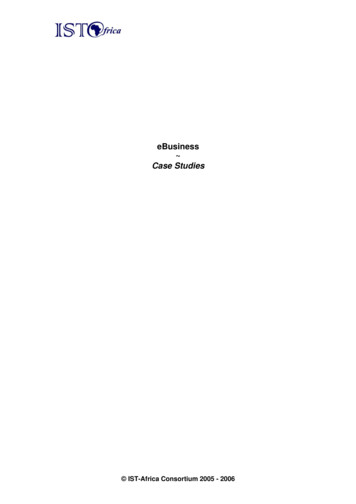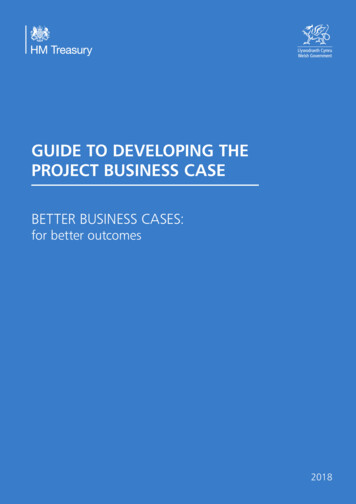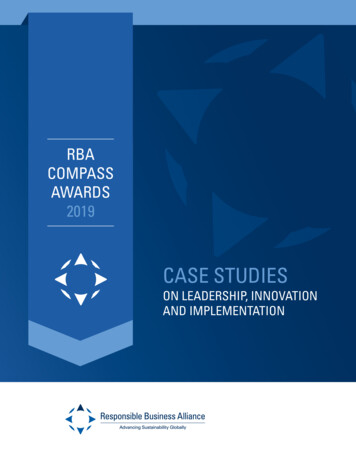
Transcription
RBACOMPASSAWARDS2019CASE STUDIESON LEADERSHIP, INNOVATIONAND IMPLEMENTATION
TABLE OF CONTENTSINTRODUCTION. . . . . . . . . . . . . . . . . . . . . . . . . . . . . . . . . . . . . . . . . . . . . . . . . . . . . . . . . . . . . . . . . . . . . . . . . . . . 1LEADERSHIPDell – Accelerating the Circular Economy with Rare Earths Minerals. . . . . . . . . . . . . . . . . . . . . . . . . . . . . 2Cisco – Cisco’s Circular Advantage. . . . . . . . . . . . . . . . . . . . . . . . . . . . . . . . . . . . . . . . . . . . . . . . . . . . . . . . . . 4Signify – Signify Carbon Neutral Program. . . . . . . . . . . . . . . . . . . . . . . . . . . . . . . . . . . . . . . . . . . . . . . . . . . . 6INNOVATIONVolvo Car Group – Pioneering Complete Traceability for Cobalt Used in Electronic Vehicles 8Best Buy – Worker Empowerment Program . . . . . . . . . . . . . . . . . . . . . . . . . . . . . . . . . . . . . . . . . . . . . . . . . 10Microsoft – Empowering Workers Through Microsoft’s Worker Voice Hotline . . . . . . . . . . . . . . . . . . . 12IMPLEMENTATIONMicrosoft – Climate Change Leadership Through Collaboration and Capacity Building. . . . . . . . . . . . 14Flex – Creating an Inclusive Factory for People with Disabilities . . . . . . . . . . . . . . . . . . . . . . . . . . . . . . . 16Micron – Successful Implementation of RBA Code of Conduct. . . . . . . . . . . . . . . . . . . . . . . . . . . . . . . . . 18
INTRODUCTIONThe Responsible Business Alliance (RBA) launched the Compass Awards formembers, their suppliers and factories in 2018. Its primary objective is to recognize and encourage efforts that lead to meaningful, positive change in line withthe RBA’s vision and mission. The awards program celebrates corporate socialresponsibility excellence across three categories: Leadership, Innovation, andImplementation. Many of the award submissions will also serve as examples ofsuccessful actions that other companies can emulate.In the Leadership category, RBA members must demonstrate a high-level commitment to corporate social responsibility (CSR), embedding it as a core businesspractice and supporting it with a large investment in time, money or otherresources. The Innovation category requires members, with or without partners, toshow a highly effective program that represents an innovative solution to a CSRchallenge. The Implementation category is open to any factory, member or supplierfacility that can demonstrate an impressive application of CSR at the site level thatis well-documented and repeatable by other sites.The Compass Awards recognizeand encourage efforts that lead tomeaningful, positive change in linewith the RBA’s vision and mission.All entries were reviewed and scored by an independent panel of judges from intergovernmental organizations and civil society. The finalists and winners of the 2019RBA Compass Awards, highlighted herein, were announced during a ceremony atthe Responsible Business 2019 annual conference in Santa Clara, California.For information on the Compass Awards, please contactawards@responsiblebusiness.org and visit this page on the RBA website:responsiblebusiness.org/compass-awardsC A S E S T U D I E S O N L E A D E R S H I P, I N N O VAT I O N A N D I M P L E M E N TAT I O N1
LEADERSHIPACCELERATING THE CIRCULAR ECONOMYWITH RARE EARTHS MINERALSUsing closed loop recycled rare earthmaterial helps eliminate portions ofenvironmental and social impacts ofmining, mitigates political and business risks associated with virgin material, and emphasizes Dell’s position asan environmental leader.An increasing number of electronic devices that usemagnets built from rare earth metals, including harddisk drives, MRI machines, and motors from electric/hybrid vehicles, are being scrapped in landfills. Thesescrapped devices contain the potential for recycling,although less than 1 percent of rare earth metalsworldwide were recycled as of 2011.At the same time, mines with low safety andenvironmental standards control the market forvirgin rare earth metals. The ore is often found withradioactive materials and, according to research byThe Guardian, processing one metric ton of rareearths produces 2,000 metric ton of toxic waste.Businesses seeking to build a transparent supplychain try to hold their suppliers to a high standardwhen purchasing these metals and can face acomplicated process of checking and trustingsuppliers. For businesses such as Dell, findingsources other than mines to source the neededmetals used within so many products is a priority.Despite their name, rare earth elements are notactually “rare” – it’s just hard to find them ineconomically viable concentrations. What’s more,they usually appear together and are thus co-minedand co-processed. This means that a change indemand for a particular rare earth element generally2affects the supply of all rare earth elements. It’s nosurprise, then, that market volatility and supply issuespose a real threat to the industry.It’s within this context that Dell began working withits partners, hard drive supplier Seagate and IT assetdisposition company Teleplan, to investigate waysto recycle rare earth magnets and to create a pilotproject that feeds recovered rare earth magnets intothousands of new hard drives.APPROACH AND SOLUTIONHard disk drives rely on magnets made from the rareearth metal neodymium. According to a market studycited by Stanford Magnets, the industry uses about4,000 metric tons of neodymium-iron-boron (NdFeB)magnets in hard drives annually, accounting forabout 50 percent of sales for the magnets. Recyclinge-waste poses an excellent opportunity to addressthe challenges around magnets made from this rareearth metal.Mining end-of-life hard drives and IT equipment forrare earth oxides allows them to be used to augmentsupply, buffer market volatility, and avoid a portion ofadditional mining. In one year, about 1.4 million harddisk drives are scrapped from the Dell return streamworldwide. Each of these is an opportunity to replacethe total hard disk drives that Dell purchases in thesame time frame.In early stages, Dell looked at various recoverymethods that had been tested previously andconcluded it would be best to separate the magnets,extract neodymium oxide, and reform them intopowerful neodymium-iron-boron permanent magnetsfor new drives.RESPONSIBLE BUSINESS ALLIANCE
LEADERSHIPDell’s process differs from others exploring magnetrecycling by allowing the magnets to be reformedinto many different shapes. As a result, the recycledmagnets can be used in numerous drive modelsboth at Dell and across the IT industry, no matter thebrand. These recycled magnets can even be used forapplication in other industries. As a result, this changeis helping advance rare earth oxide recovery andmarket access as a whole.Dell assembled a cross-functional core team withleadership support from across the company toexecute the solution, with representatives frommanufacturing operations, procurement, engineering,quality and development, logistics, environmentalaffairs, marketing, and social impact. Its goals wereto demonstrate the feasibility of recycling rare earthmagnets from end-of-life hard drives back into newdrives, measure the potential impact, and identifyopportunities for scale across the industry.KEY OUTCOMESOn Earth Day 2019, Dell, Teleplan and Seagateannounced the successful introduction of theindustry’s first closed-loop process for recoveringrare earth magnets. This process uses recycledhard-disk drives to create new drives for use in newcomputers. Using closed-loop recycled rare earthmaterial helps eliminate portions of environmentaland social impacts of mining, mitigates political andbusiness risks associated with virgin material, andemphasizes Dell’s position as an environmentalleader.These new drives began shipping in May 2019.The initial pilot created 25,000 new hard drives fornotebooks.The greatest benefits of closed-loop rare earthmagnets come from addressing the damage manyrare earth mines cause for the environment andsociety. In areas around mines people suffer fromcancer, plants are unable grow, livestock are mutated,and those in the surrounding areas are breathingdangerous sulfuric acid. Every ton of isolated rareearth elements creates one ton of solid wastecontaining radioactive elements, 20,000 gallonsof acidic wastewater, and airborne contaminantsincluding 10,000 cubic meters of acid gas fumes withdust containing radionuclides.Dell’s closed-loop rare earth initiative offersan alternative source to help address theseenvironmental and social impacts, while alsocontributing to the corporation’s greater drive to helpthe planet and global communities. The closed-looprare earth magnet pilot between Dell, Seagate, andTeleplan alone displaced roughly 100kg of mined rareearth oxides to make 25,000 hard-disk drives.C A S E S T U D I E S O N L E A D E R S H I P, I N N O VAT I O N A N D I M P L E M E N TAT I O N3
LEADERSHIPCISCO’S CIRCULAR ADVANTAGECisco and other companies rely on natural resourcesto make and ship their products. However, theforecast end of the viable availability of critical rawmaterials will cause a substantial business continuityrisk if companies continue to operate as usual.Cisco seeks to be a leader in the transformation toa circular economy, and introduced a new, enterprise-wide circular economy program in 2018. Thecompany’s holistic approach extends from how itdesigns, builds and delivers products, to how itvalues the assets it has and turns them into newproducts. Beyond that, Cisco understands that itcan drive change beyond its own walls by enablingcurrent and potential customers to use its technologyto shape their own sustainable solutions.Cisco has set ambitious goals and committed thenecessary resources to make meaningful progressin reducing its environmental impact and advancinga circular economy. The company is driving circularadvantage through a series of initiatives, includingclosed-loop plastics and waste-free operations,increasing recycled content in products and packaging, standardizing and modularizing components,and driving and measuring value from existingsolutions.The road to a circular economy cannot be paved byCisco alone. The company is committed to collaborating across its suppliers, partners, peers, and thecommunities it serves to achieve this vision, globallyand locally.APPROACH AND SOLUTIONCisco is focused on accelerating the adoption ofcircularity with the aim of decoupling business4growth from the consumption of finite resources,designing waste out of the system, and transitioningto renewable energy. The company works to embedcircular economy-driven approaches and businessmodels in its own internal and extended operations;enable circular economy for its customers; andengage in the larger ecosystem to advance thecircular economy across industries and sectors.Cisco’s circular economy initiatives are focused onfive major areas:1.Circular Design: Design products and packagingwith circularity in mind (e.g. design for reuse,repair, recycling, and resource efficiency)2. Circular Operations: Reduce consumption anduse renewable sources across our value chain3. Circular Consumption: Manage our equipmentfor multiple life cycles and deploy new businessmodels to facilitate this approach4. Circular Solutions: Shape and pioneer technology solutions and services to enable circulareconomy value creation for customers5. Ecosystem Leadership: Advance circulareconomy through industry innovation, collaboration, and public policyCisco’s circular economy program operates with adedicated program management office under theexecutive sponsorship of the SVP, Supply ChainOperations. The team runs multiple levels of governance bodies and cross-functional working groupsto establish and achieve its programmatic goals andstrategic priorities. The team also collaborates extensively with industry groups, peers, suppliers, andother stakeholders to advance the circular economy.RESPONSIBLE BUSINESS ALLIANCE
KEY OUTCOMESIn 2016, Cisco set a goal to avoid 1 million metrictons of greenhouse gas (GHG) emissions from itssupply chain by FY20. At the end of FY19, Cisco hadavoided 1,152,562 metric tons of carbon emissionssince FY12, achieving its target one year early. Thishighly collaborative effort relied on smart supply chaindecisions across the organization, from utilizing moreocean shipments, to redesigning product packaging,to energy efficiency partnerships at manufacturingsites.In FY19, Cisco launched a pilot project to betterunderstand the material used upstream in its supplychain. The company partnered with TRUE Zero Wasteto increase engagement and improve reportingcapabilities in the supply chain. Based on the results,Cisco will evaluate whether the training improvedsupplier performance and waste data reporting insupport of this goal. Additionally, Cisco will work todetermine where the biggest impacts can be madeto not only reduce material waste, but also supportits commitment to increasing the use of renewableand recovered inputs in its value chain.Cisco has set ambitious goalsand committed the necessaryresources to make meaningfulprogress in reducing itsenvironmental impact andadvancing a circular economy.Also in FY19, Cisco laid the foundation to significantlyincrease the amount of post-consumer recycled(PCR) plastic the company uses in its products. Ciscoidentified a supplier of 100 percent PCR resin andcompleted mechanical testing and color matchingto Cisco specifications for a variety of products. ThePCR resin supplier sources its PCR plastic feedstockfrom recycled electronic waste, which includes Ciscoequipment at its end of life, thus closing the loop. InFY20, the company plans to transition select modelsof the Cisco 8800 Series IP Phone and WebexRoomkit Plus to 100 percent PCR plastic resin, whichwill contribute to its work to reduce the use of virginplastic.C A S E S T U D I E S O N L E A D E R S H I P, I N N O VAT I O N A N D I M P L E M E N TAT I O N5
LEADERSHIPSIGNIFY CARBON NEUTRAL PROGRAMClimate change and carbon reduction are of keystrategic importance to Signify. In 2015, Signifyannounced its commitment to becoming 100 percentcarbon neutral in its operations and sourcing onlyrenewable electricity in 2020. An integral part ofSignify’s innovative sustainability program, BrighterLives, Better World, the effort focuses on CO2 emissions and energy use for the company’s entire globaloperations, including manufacturing, non-industrialoperations, logistics, and business travel.Signify is pioneering corporate action to the transitionto a low-carbon economy. It is the first company inits industry to commit to carbon neutrality, partneringwith peers and civil society organizations and alsodriving organizational change to achieve the targetsset. In addition, tailor-made carbon offsetting projectsuse Signify’s own lighting products to generateemissions reductions, maximizing relevance forits business. The company is bringing together aunique set of partners to accomplish this, includingthe Signify Foundation, financing partners and localentrepreneurs.Signify’s carbon reduction strategy is unique in thesense that it doesn’t just focus on reducing theenvironmental impact of the company’s own operations. The level of its commitment is exemplified byits pledge to generate 80 percent of revenues fromsustainable products, systems and services in 2020.This pledge is not only ambitious, but also dedicatesthe future of the company to delivering sustainableproducts, while simultaneously satisfying shareholders. This commitment has significant knock-oneffects on the energy efficiency of a very largenumber of public and private sector organizations andconsumers, generating a vast overall impact.Becoming a carbon neutral company in 2020 meansalso investing in carbon offsetting projects. Signifypartners with South Pole, a leader in sustainabilityservices. Through this partnership, Signify gainsaccess to decades of knowledge in the carbonoffsetting industry and a global portfolio of high-levelAPPROACH AND SOLUTIONClimate change is embedded in every part of Signify.At the corporate level, the Board of Management hasoverall responsibility for the subject. Operationally,the sustainability department is responsible for thealignment and implementation of carbon reductionsin its daily operations and reaching the agreedtargets. At site levels, environmental managersare responsible for implementing, monitoringand reporting on carbon reduction measures andactivities.6Signify carbon offset project in ZimbabweRESPONSIBLE BUSINESS ALLIANCE
Signify is the first company inits industry to commit to carbonneutrality, partnering with peersand civil society organizations andalso driving organizational changeto achieve the targets set.carbon offsetting projects. Signify is building a strategic portfolio of projects utilizing different technologies to reduce carbon emissions across all regionsof the worlds. Simultaneously, a tailor-made carbonoffsetting project is underway, created to showcasethe potential of lighting for carbon reductions andgenerate great social and environmental impact fromSignify’s own products.In addition to Signify’s contributions with energyefficient products and its carbon-neutral commitmentfor operations, the company motivates its suppliersto reduce their carbon footprints. As Signify has adirect business relationship with approximately 4,000product and component suppliers, it proactivelyinitiates, develops and supports carbon emissionreduction activities in the supply chain through itspartnership with the CDP Supply Chain program.Signify actively educates existing and potentialcustomers about the benefits of switching to energy-efficient connected LED lighting. The Signifysustainability team delivers regular presentations toorganizations and influencers and invests heavily inactivities aiming to education organizations about thebenefits of LED lighting.KEY OUTCOMESAt an organizational level, Signify’s program hasachieved significant success. In 2019, a 56% reduction of our net CO2 footprint was achieved, comparedwith 2018, resulting in a net carbon footprint of 64kilotonnes. In 2019, Signify procured 94% of its electricity from renewable sources and became carbonSignify operational carbon footprint (kilotonnes CO2e)neutral in 15 markets. By showing leadership on itsjourney to carbon neutrality, Signify’s employees arebecoming ambassadors for sustainability. Internalbenefits of the company’s optimization approach areenergy savings and costs reduction, among others.At the supply chain level, the sustainability challengesthat Signify addresses often requires the company toengage beyond its own operations. Signify engagesits supply chain to reduce its carbon footprint andsupports carbon emission reduction activities in thesupply chain through its partnership with the CDPSupply Chain program. In 2019, Signify invited 404(281 in 2018) of its strategic suppliers to the program,of which 73% submitted the 2019 CDP questionnaire,which is an increase of more than 80% compared to2018. This represents 87% of project related spend,which is significantly higher than 2018 (60% of thespend). Signify believes this increase is due to abetter understanding of the issue by its suppliers.C A S E S T U D I E S O N L E A D E R S H I P, I N N O VAT I O N A N D I M P L E M E N TAT I O N7
INNOVATIONPIONEERING COMPLETE TRACEABILITYFOR COBALT USED IN ELECTRIC VEHICLESThe production of minerals such as cobalt used inthe manufacture of lithium-ion batteries has potentialadverse social and environmental impacts. Volvo Carsrecognized this challenge and the need for a moreeffective and transparent solution to prove that theraw materials used in its supply chain to produceproducts had indeed been responsibly sourced.Volvo Cars’ battery cell suppliers for forthcomingelectric vehicle (EV) platforms are required to implement systems that provide full traceability of cobaltmaterials – the embedded supply chain must providea chain of custody for cobalt with known provenanceduring its journey through the supply chain to VolvoCars. This provides management and stakeholderswith confidence that the cobalt used in EVs originated from production sources complying withresponsible sourcing standards.Unfortunately, battery cell suppliers were largelyunable to efficiently and effectively provide rawmaterial traceability. The raw material supply chainsin question are also intricate and involve a complexweb of highly diverse actors further upstream. Rawmaterials, by their nature, are difficult to reliably tag– the material transforms on its journey from sourceto end use, so that a new identity needs to be addedafter each transformation that inherits the provenanceof the material and destroys the old identity.In order to address these issues, the solution had tospan the full supply chain to provide an end-to-enddigital chain of custody system. This started withscrap lithium-ion batteries from discarded phones andlaptops from which the raw materials were recovered, then tracked right through the supply chain totheir battery manufacturer, and finally to Volvo Cars.8The objective was to verify and demonstrate withcertainty that no material that wasn’t responsiblysourced entered the supply chain at any point.APPROACH AND SOLUTIONVolvo Cars worked with Circulor and implemented adistributed-ledger technology (blockchain) solution totrack materials, including as the materials change andare amalgamated with other materials, to create animmutable chain of custody record within the supplychain. When combined with supplier audits, thiscreates a totally new standard in verified responsiblesourcing. Artificial intelligence algorithms supporteddue diligence and identified data anomalies to targetcompliance and investigative action.The solution digitally tracked recycled cobalt throughmultiple manufacturing and transformation processesacross participants in the supply chain: Tracking physical movements of tonnes ofrecycled cobalt throughout its 3,500 km journeyacross China via multiple refiners and manufacturing facilities to Volvo Cars; Tracking recycled cobalt in its various physicaltransformations throughout the manufacturingprocess across the battery supply chain; and Validating integrity of traceability – with proof oftime, duration, location (GPS) and mass balanceof input and output all met expected outcomes(within set thresholds).The solution creates a digital twin of a commodity,which is tagged with either QR codes or IoT devices,and that allows the identity of material to be inheritedRESPONSIBLE BUSINESS ALLIANCE
by successor products at each processing or manufacturing step. This way, a raw material at its source,which then morphs many times until it becomes abattery, can be reliably tracked through the supplychain.The solution digitally tracked the flow of cobaltmaterials through the supply chain and created digitalrecords at designated process points, then verifiedand updated to the blockchain to create an immutablechain of custody.KEY OUTCOMESThe solution successfully tracked recycled cobaltthrough multiple manufacturing and transformationprocesses across many participants in the supplychain. This outcome was achieved on time and onbudget, and in a frictionless manner – minimal ITinvestment or technical implementation was requiredby the participating suppliers and there was minimaldisruption and change to existing production andcontrols processes.The long-term impact is that thiswork demonstrates that a newapproach to traceability in supplychains is feasible, economic,scalable and capable of wideradoption across industries.The solution provided assurance that no cobalt ofunknown origin entered the supply chain at anystep of the process. It also solved the traceabilityproblem by utilizing technology to provide materialswith a unique identity and then track the flow ofthis material, rather than merely implementing ablockchain-branded process automation tool that justdigitizes existing ways of working without solving anyof the existing challenges.The effort of adoption by suppliers with varying ITcapabilities to provide paperless digital updates wasminimal, ranging from the use of a mobile applicationto standard APIs. This solution is being deployed forwider adoption across Volvo Cars’ EV supply chain.The long-term impact is that this work demonstratesthat a new approach to traceability in supply chainsis feasible, economic, scalable and capable of wideradoption across industries. It creates a new benchmark standard in an environment that is currentlydominated by self-certification.This initiative helped defined the way forward forraw material traceability for both current and futureproduction approaches. When adopted at-scale, thissolution will also deliver significant savings to thesupply chain participants and will be the defacto waybusiness and responsible sourcing is conducted inthe automotive industry.The innovation has the potential for global adoption,and other car manufacturers are starting to adopt thesame system as that used by Volvo Cars.C A S E S T U D I E S O N L E A D E R S H I P, I N N O VAT I O N A N D I M P L E M E N TAT I O N9
INNOVATIONWORKER EMPOWERMENT PROGRAMFactories in China face a difficult labor market andoften struggle to retain workers for a variety ofreasons. Based on numerous conversations withfactory managers and workers over the past severalyears, Best Buy believes one factor is management’sinadequate response to the changing attitudes andexpectations among the current generation of factoryworkers.Whereas previous generations prioritized maximizingtheir hours and pay to cover basic needs, many oftoday’s factory workers have expectations for careerdevelopment and more of a work/life balance. Whenthose expectations are not met, workers often seekemployment elsewhere. This can have a negativeimpact on factory performance, a detrimental effecton the quality of products produced, and lessen theability for a factory to be a reliable supplier.After conducting worker surveys at several factories in 2016-2017, Best Buy learned that a poorline-worker/line-supervisor relationship contributedto turnover. Further, the company believed thatthese poor relationships, which is one example ofmanagement not meeting the current generation’sexpectation for a more respectful workplace, indicateboth a lack of soft skills and the potential for codeviolations related to humane treatment, workerfeedback, and non-retaliation. These risks are furthercompounded by the lack of managerial training andcoaching received by line supervisors, who are oftenstill early in their careers and have yet to gain enoughskills to effectively lead in the fast-paced, high-pressure environment of the factory floor.Best Buy developed a Worker EmpowermentProgram that sought to improve code compliance andreduce turnover by further developing the soft skillsof line supervisors. The company believes its trainingprogram will help factories better compete forworkers who are looking for a workplace that meetstheir expectations.APPROACH AND SOLUTIONIn collaboration with its partner, Verite, Best Buyprovided four training courses focused on managerialcapabilities including Communication Skills andConflict Management, Situational Leadership,Comparison of Turnover Rates for the Untrained Group vs. Trained Group10RESPONSIBLE BUSINESS ALLIANCE
Stress Management, and Self-Awareness. Theprogram was designed to change the line supervisors’ behavior, including how they listen, communicate and respond to feedback in their daily work, andto make them aware that their behavior impacts theworkers’ well-being and job satisfaction.To further understand the training needs ofline supervisors at the participating factories, apre-training survey was used to collect information onhow workers view their supervisors, including theirapproach to communications, their stress management skills and leadership style. The survey resultswere used to design the training materials.The four courses used many case studies andenabled participants to not only shift their mentalapproach to management, but also to draw on alarger set of tools in their daily management. Bydelivering the courses over a four-month period, linesupervisors were able to reflect on course content,apply learnings to their interactions with workersand even share their experiences through a WeChatgroup established for program participants.Outcomes achieved include highsatisfaction among the trainingparticipants, improved perceptionsof line-supervisors amongline-workers and a statisticallysignificant reduction in turnover inthe months post-training.Best Buy hoped the Worker Empowerment Programwould start to change the factory’s human resourcesand training systems. Management would increasingly recognize the need to modify and enhance trainings, with a focus on soft skills and a growth mindset.HR would support a system change by setting higherexpectations for line supervisors’ people management performance and hiring those with a mindsetand skills that are more focused on people in order todrive business performance.KEY OUTCOMESTwo strategic factories participated in the program,with 48 supervisors and more than 200 workersinvolved. Outcomes achieved include high satisfaction among the training participants, improvedperceptions of line supervisors among line workersand a statistically significant reduction in turnover inthe months post-training.For the program measurement, Best Buy sought
CASE STUDIES ON LEADERSHIP, INNOVATION AND IMPLEMENTATION 1. 2 RSSIBL BSISS ALLIAC An increasing number of electronic devices that use . business risks associated with virgin material, and emphasizes Dell’s position as an environme

